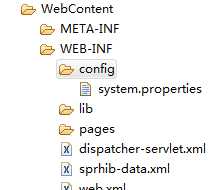标签:
@value
在现阶段我想大家对注解都不陌生,@value的用法就是在后台获取配置文件的信息,从而方便修改一些固定的配置。不明白的可以百度@value的详解。
配置@value有以下几个步骤。
1、首先新建一个配置文件,system.properties
目录结构如下图

内容如下
jdbc.jdbcUrl=jdbc:mysql://localhost:3306/commentDemo?useUnicode=true&characterEncoding=UTF-8
2、配置xml文件。就是spring的那个配置文件,添加如下内容
<!-- @value注解 --> <bean id="configProperties" class="org.springframework.beans.factory.config.PropertiesFactoryBean"> <property name="locations"> <list> <value>WEB-INF/config/system.properties</value> </list> </property> </bean> <bean id="propertyConfigurer" class="org.springframework.beans.factory.config.PreferencesPlaceholderConfigurer"> <property name="properties" ref="configProperties" /> </bean>
3、在controller中使用
@Controller @RequestMapping("userManager") public class UserController extends BaseController{ @Value("#{configProperties[‘jdbc.jdbcUrl‘]}") private String jdbcUrl; @Resource private UserDao userDaoImpl; @RequestMapping(value="/showList") public String showList(Model model){ System.out.println(jdbcUrl); return "index"; }
4、查看结果如下

标签:
原文地址:http://www.cnblogs.com/wangxiangstudy/p/5178972.html